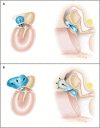A fluorescent photoimmunoconjugate for imaging of cholesteatoma
- PMID: 36402793
- PMCID: PMC9675863
- DOI: 10.1038/s41598-022-22072-9
A fluorescent photoimmunoconjugate for imaging of cholesteatoma
Abstract
Cholesteatoma is a potentially serious complication of chronic ear infections and requires surgical intervention for definitive management. Long-term complications include a frequent need for repeat surgical intervention for disease recurrence, and techniques to improve efficacy of single-stage surgery are an important area of continued research. This study investigates a novel application of the photosensitizer immune conjugate (PIC) cetuximab-benzoporphyrin derivative (Cet-BPD) for in vitro localization of human cholesteatoma tissue, coupled with an in vivo safety study for middle ear application of Cet-BPD in a murine model. In fresh human cholesteatoma tissues, Cet-BPD demonstrates selective localization to the hyperplastic squamous cell tissue associated with cholesteatoma, without localizing to other tissues such as middle ear mucosa. Applied to the murine middle ear, Cet-BPD does not demonstrate any deleterious effect on murine hearing when assessed by any of auditory brainstem response (ABR) thresholds, distortion product otoacoustic emission thresholds, or ABR wave I amplitudes. These findings demonstrate the technical promise and encouraging safety profile for the use of PICs for intraoperative localization and treatment of cholesteatoma.
© 2022. The Author(s).
Conflict of interest statement
The authors declare no competing interests.
Figures



References
-
- Jackler, R. & Gralapp, C. Ear surgery Illustrated: A Comprehensive Atlas of Otologic Microsurgical Techniques. 1 edn, (Thieme, 2019).
Publication types
MeSH terms
Substances
Grants and funding
LinkOut - more resources
Full Text Sources

